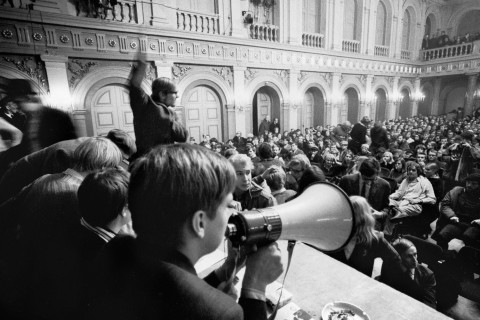A new book sheds light on the history of student protests in Europe.
This year marks the 50th anniversary since European university students took to the streets to demand the democratisation of university administration, among other things. Starting in Paris, the student movement also showed its strength behind the Iron Curtain in Eastern Europe.
The waves of protest were felt in Finland, too, when students occupied the Old Student House in Helsinki.
“The occupation of the Old Student House was an extraordinary incident in the 1968 student unrest. During the course of events, Finland’s then President Urho Kekkonen sided with the students. Moreover, the occupation of the Old Student House indeed started as a protest against the university’s administration, but developed into a symptom of the internal division of the student movement,” researcher Pieter Dhondt says.
Together with Elizabethanne Boran, he is the co-editor of the Routledge book Student Revolt, City, and Society in Europe, focusing on the European history of student protests from medieval times to the present. The book points out that although every new generation of students thinks that they are the first ones to man the barricades, Europe in fact has a long history of student protests.
“One can certainly go further back than the emergence of the classical student movement at the beginning of the 19th century to find examples of collective action by students to influence society.”
Not all student protests have been about overturning the status quo, though. In Germany, for example, students protested against the liberal ideas introduced by the French Revolution. According to Dhondt, the German student movement also constitutes a turning point that is indicative of a change in the relationship between the university and the surrounding society.
“It’s a nice example of the transition from traditional ’town and gown’ conflicts to closer relationships between the university, especially its administration, and the city or state administration.”
Previously, the academic community could choose to relocate in the event of a conflict with the local administration.
“In this case however, not the university as a whole, but only the students moved to another city and started up their own university there, by way of protest.”
The relationship between the university and the surrounding society is a theme Dhondt also focuses on in his new research project.
“There was some collaboration between universities and state administration as early as in the Middle Ages, but nowadays collaboration is almost a given fact.”
Collective student identity is perhaps the most common cause of student unrest.
The German student movement is a good example of the student protests introduced in the book. The authors have hand-picked some interesting examples of student unrest from different centuries.
In Italy, for example, students at the University of Padua demanded Italian involvement in the First World War.
“They looked at the war from a global perspective and felt that Italians should bear their responsibility in the war.”
Furthermore, not all student protests have been initiated by students: professors have also played their part in encouraging student unrest.
What ignites the spark in student protests? One of the questions on the researchers’ minds has been whether student protests are caused by adolescent rebellion or collective student identity. The numerous examples found in the book show traces of both.
“However, collective student identity is perhaps the most common cause of student unrest.”
The authors also encourage students to point out injustices in the future and to man the barricades when needed. Although today’s students are sometimes accused of inadequate societal engagement, the 2010s feature numerous examples of student protest.
In Finland, students have organised demonstrations and occupied university buildings to oppose the country’s new university legislation and cuts in student financial aid. Students at the University of Amsterdam, in their turn, occupied two university buildings in 2015 in protest of cuts in funding for education. In the same year, students in the UK protested against the neo-liberalisation of the country’s education system.
“In other words, today’s students are more than ready the man the barricades,” Dhondt says.
He says that public sentiment towards student protests is usually more positive than towards other protests. This is partly due to students being part of society’s elite.
“There is something of a paradox there.”
The students moved to another city and started up their own university there, by way of protest.

From Belgium to a small rural village in eastern Finland
Born in Belgium, Pieter Dhondt works as Senior Lecturer at the Department of Geographical and Historical Studies at the University of Eastern Finland. Specialising in university history, Dhondt came to Finland in 2005 to work as a postdoc researcher at the University of Helsinki.
His research focuses on the intercultural transfer of university ideas within Europe in the 19th century, the history of academic mobility and developments in medical education, among other topics.
Since 2010, Dhondt has been working at the University of Eastern Finland, and he and his family live in a rural part of Eastern Finland.
“For a time, we lived in Belgium, but we wanted to return to Finland,” Dhondt says in fluent Finnish.
Learning the Finnish language has helped him to integrate into the local village community.
